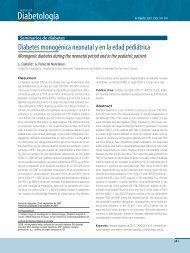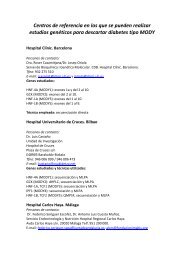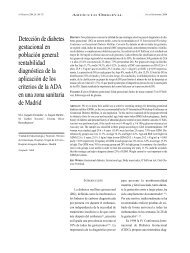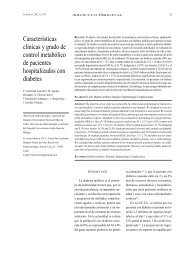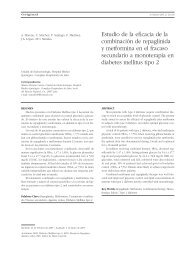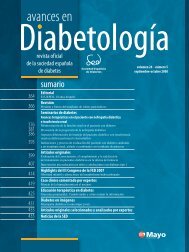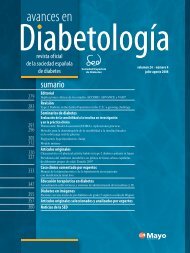Avances en DiabetologÃa - Sociedad Española de Diabetes
Avances en DiabetologÃa - Sociedad Española de Diabetes
Avances en DiabetologÃa - Sociedad Española de Diabetes
- No tags were found...
You also want an ePaper? Increase the reach of your titles
YUMPU automatically turns print PDFs into web optimized ePapers that Google loves.
Glucose monitoring in clinical diabetes: reality and promises Vol. 21 Núm. 1 - <strong>en</strong>ero-marzo 2005 17• Continuous glucose monitoring for prolonged periodsof time.• Stable measurem<strong>en</strong>ts without drift.• A precise and accurate measurem<strong>en</strong>t.• On-line display of the measured data• Tr<strong>en</strong>d information• No need for frequ<strong>en</strong>t re-calibrations• No si<strong>de</strong> effect (intact skin/ no skin reactions), and itshould be• Small, with nearly no weight and with “no” additionalcosts related to one-used accessories like s<strong>en</strong>sors,etc.WHO IS DEVELOPING NEW GMS?A consi<strong>de</strong>rable number of companies are curr<strong>en</strong>tly workingon the <strong>de</strong>velopm<strong>en</strong>t of minimal-invasive GMS; most ofthem are based in the US (Abbott, Animas, Bayer (Germany/US),Dexcom, iS<strong>en</strong>se, Medtronic MiniMed, M<strong>en</strong>ariniDiagnostics (Italy), Roche Diagnostics (Germany), SpectRx,Theras<strong>en</strong>se). Also a number of companies are workingon the <strong>de</strong>velopm<strong>en</strong>t of non-invasive systems (Animas, CMETelemetrix (Canada), Glucon Medical Ltd (Israel), IntegrityApplications (Israel), InLight Solutions, LifeTrac Systems,LighTouch, MedOptix, MicroS<strong>en</strong>se, OrS<strong>en</strong>se (Israel), P<strong>en</strong>dragon(Switzerland), S<strong>en</strong>sys). Most probably this list is notexhaustive. Due to the fact that this area of research is ahighly competitive one, the information politics of some ofthe companies appear to be driv<strong>en</strong> by the i<strong>de</strong>a to make alot of smoke out of a little fire. This is un<strong>de</strong>rstandable inview of the fund raising problems many companies have,but it blurs the view.PHYSIOLOGYThe technological achievem<strong>en</strong>ts that have be<strong>en</strong> ma<strong>de</strong>with the curr<strong>en</strong>tly available GMS in terms of measurem<strong>en</strong>tprecision and reliability allow rising of physiology relatedquestions, e.g., what are the relationships betwe<strong>en</strong> variousmeasurem<strong>en</strong>t signals and changes of glucose levels in blood,extra-vascular compartm<strong>en</strong>ts and within differ<strong>en</strong>t tissues.The data observed in the first studies looking in this makeclear that this is a complex story. A number of aspects haveto be tak<strong>en</strong> into account:• Which glucose levels are measured in which compartm<strong>en</strong>t(blood/interstitial fluid/mixed signal) and at whichbody site?• If differ<strong>en</strong>t s<strong>en</strong>sors measure glucose in differ<strong>en</strong>t compartm<strong>en</strong>t,are the results obtained comparable?• What is the impact of insulin in varying levels on therelationship betwe<strong>en</strong> glucose levels in blood and theinterstitial fluid?• Which impact has the calibration procedure on the displayedresults?In or<strong>de</strong>r to learn more about these relationships, more<strong>de</strong>tailed studies are required especially experim<strong>en</strong>ts withrapid changes in blood glucose levels. Such studies can alsoclarify if there are differ<strong>en</strong>ces in the relationship betwe<strong>en</strong>glucose levels in blood and interstitial fluid at states ofincreased or <strong>de</strong>creased glucose clearance. Nevertheless,un<strong>de</strong>r such conditions it can be difficult to differ<strong>en</strong>tiatebetwe<strong>en</strong> physiology and technology related factors that influ<strong>en</strong>cethe observed results. Other factors (e.g. local woundreactions with invasive systems) can also have an impact onthe results obtained.CALIBRATIONUsually the glucose s<strong>en</strong>sors do not provi<strong>de</strong> an absoluteglucose measurem<strong>en</strong>t, but the measured signal (most oft<strong>en</strong>an electric curr<strong>en</strong>t) must be calibrated to the curr<strong>en</strong>tly prevailingblood glucose level by means of a conv<strong>en</strong>tional capillaryblood glucose measurem<strong>en</strong>t. I<strong>de</strong>ally the glucose levelsin blood and interstitial fluid should be id<strong>en</strong>tical whilethis procedure takes place. In case of profound differ<strong>en</strong>cesin glucose levels betwe<strong>en</strong> both compartm<strong>en</strong>ts no calibrationshould be performed. If this precaution is ignored, all subsequ<strong>en</strong>tlyshown results can be severely flawed, which canresult in pot<strong>en</strong>tially life threat<strong>en</strong>ing errors 3 . This is an issuethat is difficult to overcome. However, also attempts arema<strong>de</strong> to <strong>de</strong>velop GMS that need no re-calibration at all orat least in very long intervals. In view of all the factors thathave an impact on a “successful” calibration, one has to statethat this is an elusive goal.“AST-LIKE” PHENOMENONThe limited reliability of the glucose monitoring withGMS so far has not allowed to study the relevance of the socalled Alternate Site Test (AST)-ph<strong>en</strong>om<strong>en</strong>on. This term<strong>de</strong>scribes the differ<strong>en</strong>ces in both the time and the conc<strong>en</strong>trationdomain that were observed during rapid changes incapillary blood glucose wh<strong>en</strong> the sample was not collectedfrom the fingertip but from the forearm or the abdom<strong>en</strong>.Capillary blood samples are usually collected from the upper<strong>de</strong>rmal layers (< 2 mm), whereas GMS (i.e., CGMS and GlucoDay)measure glucose changes in the interstitial fluid inthe subcutaneous tissue, i.e., in <strong>de</strong>eper skin layers.





